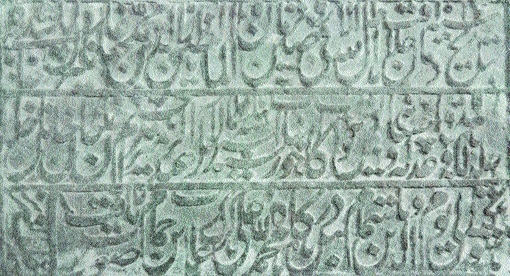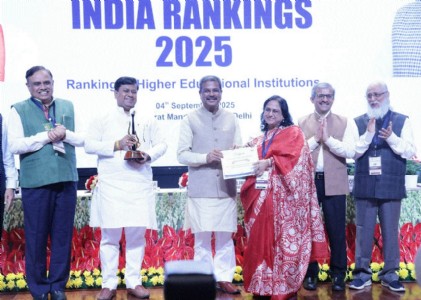Central Museum Nagpur, pride of Central India
| Date :18-May-2020 |

By G S Khwaja :
Museums disseminate the knowledge of bygone era. They provide a peep into the happenings of ancient past, life of man in the beginning of the world and his discoveries, monuments and antiquities from several countries, highlights of natural history, centuries-old civilisations, coinages and potteries. Central Museum (Ajab Bangla) at Nagpur is one of the important institutions of the city as well as Vidarbha region. Commissioned in the year 1863 during the British Rule, it was among the few distinguished museums in India. The genesis of this museum is rooted in the history of Nagpur State, of Bhosla period. Richard Jenkins was the Resident at Nagpur from 1807 to 1826 CE.

Persian epigraph of Emperor Jehangir from Hammam in Burhanpur.
During his tenure, he deputed Vinayak Aurangabadkar, his Office Assistant, to collect ancient records, inscriptions and icons from Chhattisgarh, which were published in Asiatic Researches Vol. XV (1825). Jenkins’ successor Major Wilkinson established a collection of antiquities from various places of the then Central Provinces and Berar. On October 27, 1862, a committee of five influential British officers was formed at the instance of Antiquarian Society of the Central Provinces. Richard Temple, Chief Commissioner of the province, issued a circular May 7, 1863 on the basis of which the museum was formed. Later on, those antiquities became part of Central Museum.
Housed in an imposing building with Victorian architecture, to the west of Assembly Hall in Civil Lines, it has main hall and several side rooms consisting of other galleries. A long epigraphical gallery is in the north. Separate rooms are there for mineral wealth and natural history. It is very rich in pre-Historic tools, terracotta pottery, icons, epigraphs, seals, coins, copper plates, illustrated manuscripts and paintings collected from different parts of C P & Berar.
A few attractions for kids -- folk tales depicted with models like ‘Justice of Monkey’, ‘Sour Grapes of Fox’, ‘Hare and Tortoise Race’ etc -- are worth seeing. The pre-Historic period collection has very fine specimen of hand axes from Bhandara, Kalmeshwar, Hoshangabad and Narbada valley and Copper celts from Gungeria, Balaghat district and Kesli, Sagar district. The gallery houses icons of Brahma, Shiva, Parvati, Bhairava, Narsimha, Varaha, Lakshmi, Ganesha, Kuber, etc dating back to 9th and 10th Centuries, procured from Ratanpur, Gyaraspur, Malhar, Raipur and other parts of Madhya Pradesh, Berar and present Chhattisgarh.
A few rare images of Buddha and Jaina of Third Century BCE, two statues of Kushana period found at waterfall of Narbada near Bhedaghat, Jabalpur, are also displayed. The epigraphical gallery is very rich. The oldest record here is a Mauryan epigraph found at Deotek in Chandrapur district, mentioning an edict issued in the 14th regnal year of Emperor Ashoka prohibiting hunting of animals. Another inscription from Deotek is of Vakataka, Vidarbha’s most glorious dynasty. It mentions construction of Dharma-sthana (a temple) by king Rudrasen-I dating back to middle of Fourth Century CE. Copper plates of Vakatakas, Rashtrakutas of Nandivardhan, Parivarjaka Maharajas, Kalachuris of Tripuri, Kalachuris of Ratanpur, Chalukiyas of Kalyani, Kings of Sharabhapura, Chandelas, Yadavas, etc make this collection richer. Rai Bahadur Hiralal published these plates in 1917.
The museum has some of the most important Arabic and Persian epigraphs. An epigraph of Sultan Ghayasuddin Tughlaq from Batihagarh in Damoh district of Madhya Pradesh mentions construction of a step-well in A.H. 725=1325 CE. The one belonging to the reign of Ghiyas Shah Khalji, Sultan of Malwa ruling from Mandu, records construction of a rampart wall of Damoh in A.H. 885=1480 CE. A bi-lingual inscription, virtually a direction stone, shows names of Silod and Nachangaon towns and their distances. Burhan Nizam Shah, Sultan of Ahmadnagar, set it up in A.H. 1000=1591-92 CE at Kalamb in Wardha district. It is in Persian and Marathi. The epigraph of Mughal Emperor Jahangir dated A.H. 1016=1607-08 CE is carved in Nastaliq calligraphy.
It is from a Hammam (Turkish Bath) built by Prime Minister and famous Hindi poet Abdur Rahim Khan-e-Khanan in the given year, for public use. There is a good collection of medieval coins of Sultans of Delhi, Bahmani Sultans and Mughal Emperors, with legends in Persian. M A Suboor, Curator, has published two catalogues of more than 2,000 coins of this museum under the general editorship of V P Rode. A new portion to this building was added with a first floor gallery where paintings are displayed. The museum has an oil on canvas masterpiece titled Niranjali ‘Lady with Lamp’ of Haldankar, the only of its kind painting.
The gallery has many a prized collection of the works of contemporary masters like M F Husain, Tayyeb Mehta, Amrita Shergil, M R Achrekar, Jatin Das, and others. World famous painter S H Raza, an alumnus of Chitrakala Mahavidyalaya, Nagpur, has personally gifted a few of his drawings and paintings, which are on display here. The geology gallery of the museum is arranged well. Samples of minerals and mapping of deposits near Nagpur were done so meticulously that observing quality of manganese deposits only Tatas started their Steel Plant at Jamshedpur and Indian Government commissioned Bhilai Steel Plant near Raipur. The young friends should visit this museum, which is pride of Central India. (The author is former Director of Archaeological Survey of India, Nagpur)







